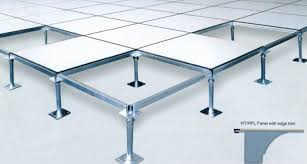

RAISED ACCESS FLOORS
A raised access floor is an elevated floor system consisting of removable, load-bearing panels laid on a grid of adjustable pedestals above a building's concrete slab or subfloor. This system creates a concealed void (plenum) for housing and distributing services, including electrical wiring, data cabling, plumbing, and HVAC systems. The removable panels allow for easy access to the services underneath for maintenance, repairs, or reconfiguration.
Components
A raised access floor system is made of several key parts that create the elevated surface and the underfloor void.
Floor panels: Modular, square panels that form the walking surface. They are typically made of a steel shell surrounding a core of cement or wood particleboard, which determines their load-bearing capacity and fire rating. Panels can come with a factory-applied finish or be bare, ready for a separate flooring material like carpet tiles
Pedestals: Adjustable vertical supports that elevate and hold the floor panels in place. The pedestals are bonded to the subfloor with epoxy resin and can be adjusted to create a level floor plane.
Stringers: Horizontal support bars that connect the pedestals. They provide added stability to the system and are often used for heavier-duty floors, such as in data centers.
Floor boxes and grilles: Panels can be customized with built-in accessories for power, data access, and air ventilation.
Applications
The versatility of raised access flooring makes it a standard solution for many commercial and technical environments.
Commercial offices: Raised floors enable flexible workspace layouts by allowing easy rearrangement of power and data points. They also help hide unsightly cables and can support underfloor air distribution systems.
Data centers and server rooms: These areas require massive amounts of cabling and cooling. Raised floors keep cables safely stored and allow for efficient underfloor cooling by distributing cold air to heat-generating equipment.
Call centers and telecommunication centers: These spaces have heavy concentrations of network and power cabling that must be managed and kept accessible.
Renovation of historic buildings: Raised access floors can be installed without damaging original flooring and building features. They provide a level surface and protect the original subfloor from wear.
Retail and showrooms: The system allows for flexible changes to display layouts and can be combined with custom finishes to achieve specific aesthetic goals.
Hospitals and laboratories: In these sensitive environments, raised floors help contain and manage complex service networks, including medical gases and lab equipment hookups.
Benefits
Raised access floors provide numerous advantages in functionality, cost-efficiency, and design.
Flexibility: The modular and removable nature of the panels allows for quick and easy reconfiguration of a space with minimal disruption.
Aesthetics: Cables and pipes are concealed within the underfloor void, creating a clean and uncluttered environment.
Easy access to services: Technicians can simply lift individual panels to access and service electrical, data, and mechanical systems.
Improved airflow and thermal efficiency: The underfloor plenum can be used to distribute conditioned air for heating and cooling. This "underfloor air distribution" is more energy-efficient and improves air quality.
Enhanced acoustics: The void space can be used with acoustic materials to dampen noise from foot traffic and external sources, improving the overall sound environment.
Future-proofing: Raised floors provide a scalable infrastructure for businesses that anticipate future growth in technology and cabling needs.
